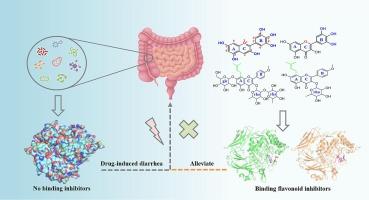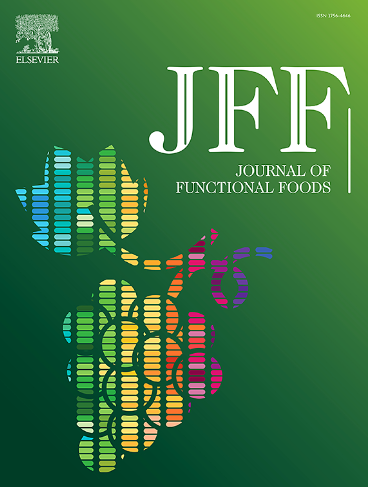深入了解抑制机制:揭示膳食类黄酮对肠道细菌β-葡糖醛酸酶的结构-活性关系
IF 4
2区 农林科学
Q2 FOOD SCIENCE & TECHNOLOGY
引用次数: 0
摘要
膳食黄酮类化合物被认为是肠道细菌β-葡糖醛酸酶(β-GUS)的强效抑制剂,但膳食黄酮类化合物与β-GUS之间确切的结构-活性关系仍不明确。本研究选择了 6 种常见的不同结构类型的 24 种膳食类黄酮作为模型分子,通过酶抑制动力学和分子对接模拟来研究这种关系。结果发现,Delphinidin(1)和baohuoside I(16)具有很强的抑制活性,而离子键和氢键的形成在这些相互作用中起着关键作用。此外,核心结构、羟基的位置和数量、糖基的类型和数量以及异戊烯基的存在都对大肠杆菌β-GUS的抑制活性起着关键作用。这些结果为了解黄酮类化合物结构与酶抑制作用之间的关系提供了宝贵的见解,对开发新型药物和黄酮类化合物膳食补充剂具有重要价值。本文章由计算机程序翻译,如有差异,请以英文原文为准。

Insights into inhibitory mechanisms: Unraveling the structure-activity relationship of dietary flavonoids on gut bacterial β-glucuronidase
Dietary flavonoids are regarded as potent inhibitors of gut bacterial β-glucuronidase (β-GUS), although the precise structure-activity relationship between dietary flavonoids and β-GUS remains elusive. In this study, 24 dietary flavonoids of 6 common different structural types were selected as model molecules to investigate this relationship through enzymatic inhibition kinetics and molecular docking simulations. The findings revealed that delphinidin (1) and baohuoside I (16) exhibited robust inhibitory activities, while the formation of ionic bond and hydrogen bonds was found to play crucial roles in these interactions. Moreover, the core structure, position, and quantity of hydroxyl groups; type and number of glycosyls, and the presence of isopentenyl group all played pivotal roles in influencing inhibitory activities against β-GUS derived from Escherichia coli. These results offer valuable insights into the relationship between flavonoid structure and enzyme inhibition, which could prove invaluable for the development of novel drugs and flavonoid dietary supplements.
求助全文
通过发布文献求助,成功后即可免费获取论文全文。
去求助
来源期刊

Journal of Functional Foods
FOOD SCIENCE & TECHNOLOGY-
CiteScore
9.60
自引率
1.80%
发文量
428
审稿时长
76 days
期刊介绍:
Journal of Functional Foods continues with the same aims and scope, editorial team, submission system and rigorous peer review. We give authors the possibility to publish their top-quality papers in a well-established leading journal in the food and nutrition fields. The Journal will keep its rigorous criteria to screen high impact research addressing relevant scientific topics and performed by sound methodologies.
The Journal of Functional Foods aims to bring together the results of fundamental and applied research into healthy foods and biologically active food ingredients.
The Journal is centered in the specific area at the boundaries among food technology, nutrition and health welcoming papers having a good interdisciplinary approach. The Journal will cover the fields of plant bioactives; dietary fibre, probiotics; functional lipids; bioactive peptides; vitamins, minerals and botanicals and other dietary supplements. Nutritional and technological aspects related to the development of functional foods and beverages are of core interest to the journal. Experimental works dealing with food digestion, bioavailability of food bioactives and on the mechanisms by which foods and their components are able to modulate physiological parameters connected with disease prevention are of particular interest as well as those dealing with personalized nutrition and nutritional needs in pathological subjects.
 求助内容:
求助内容: 应助结果提醒方式:
应助结果提醒方式:


